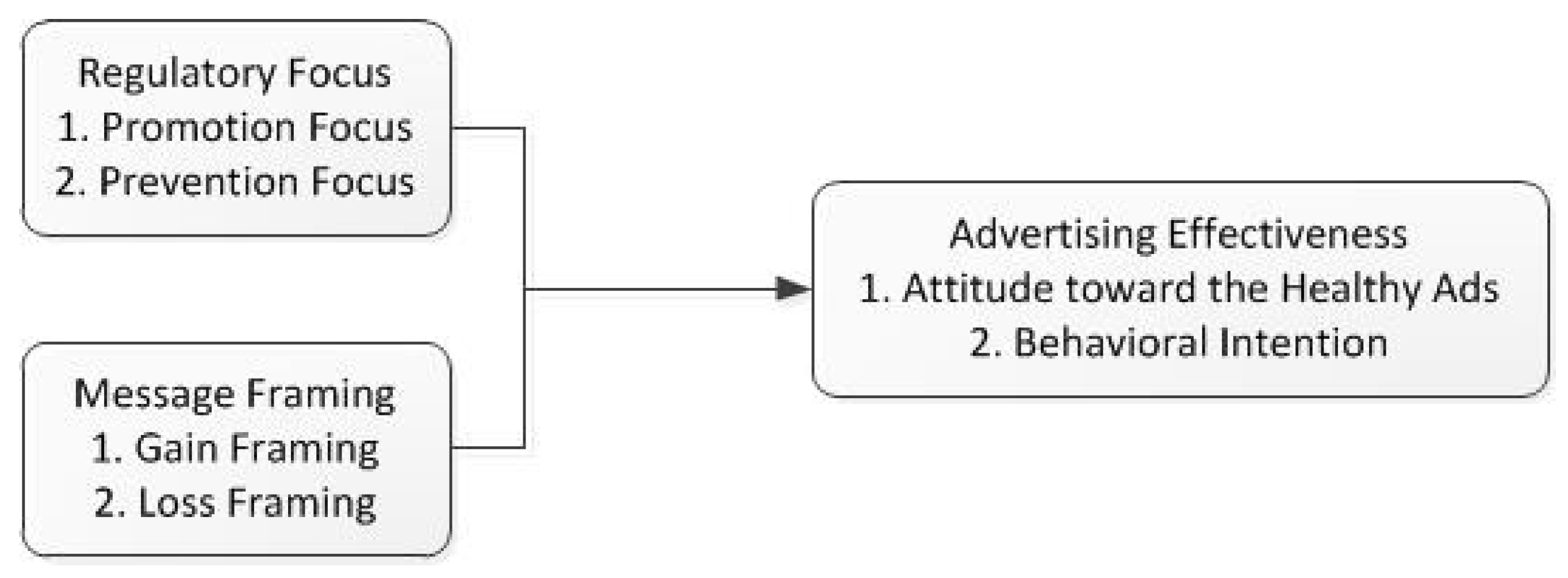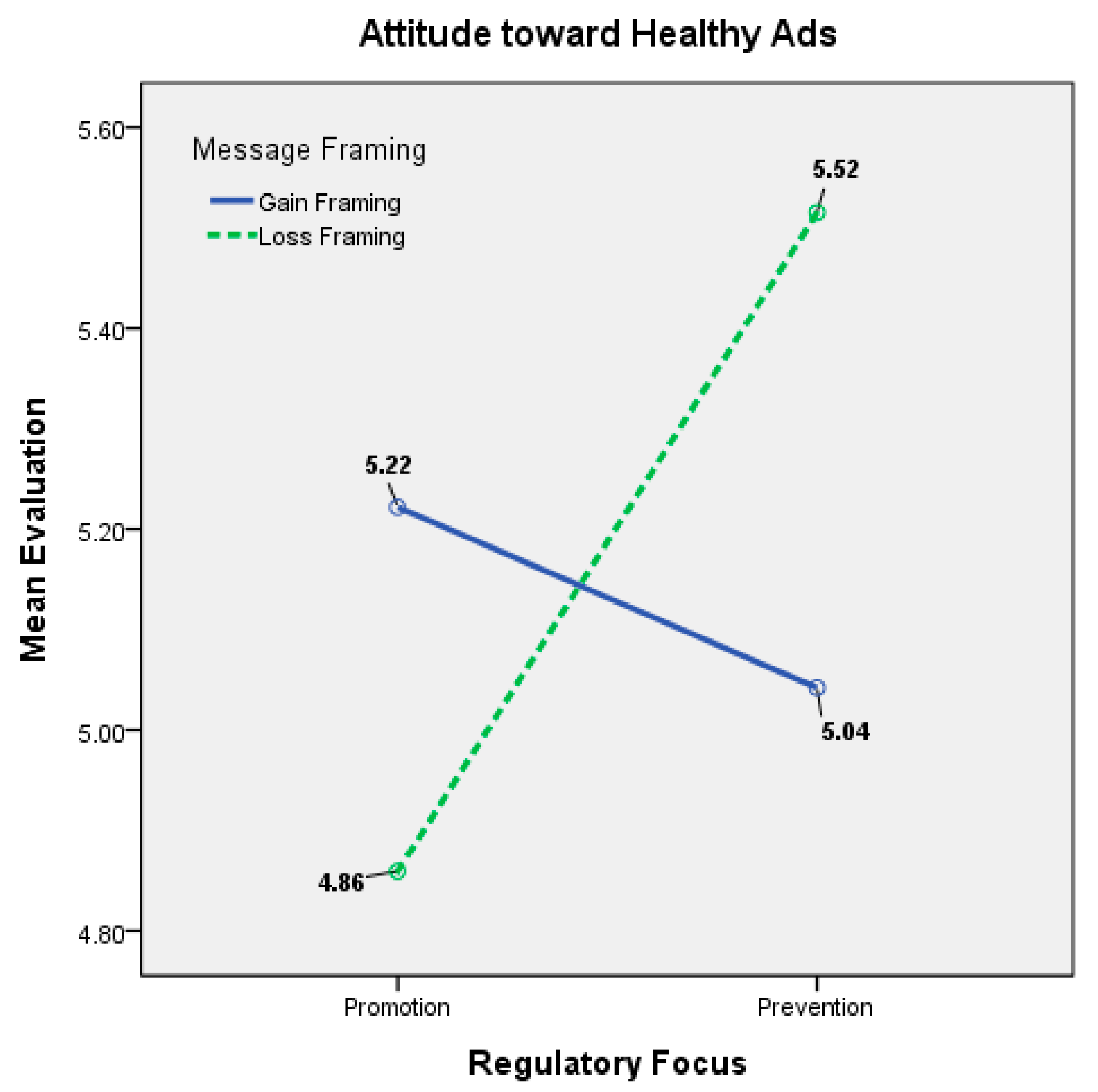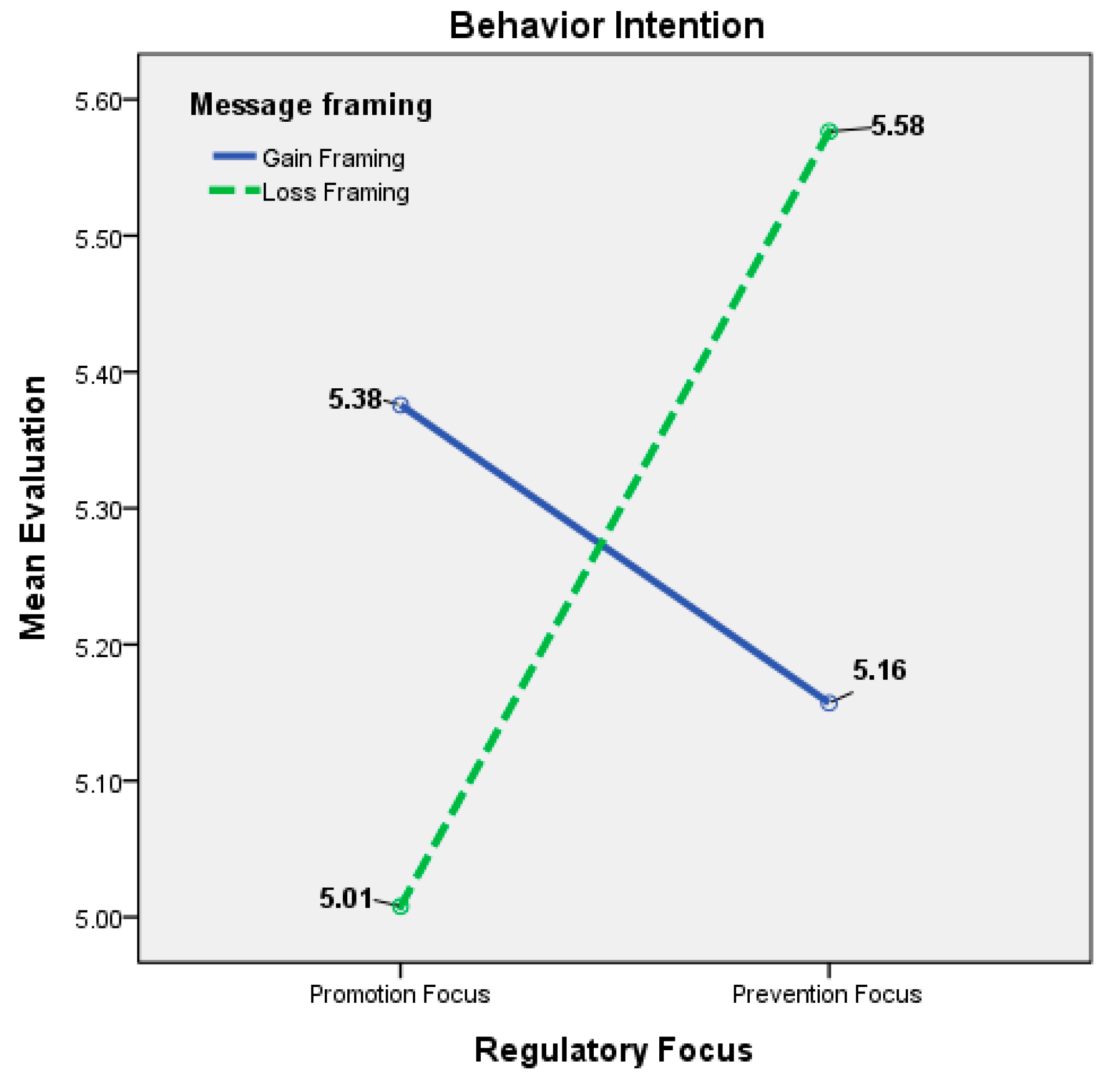How Does Health-Related Advertising with a Regulatory Focus and Goal Framing Affect Attitudes toward Ads and Healthy Behavior Intentions?
Abstract
:1. Introduction
1.1. Literature and Hypotheses
1.1.1. Regulatory Focus Theory and Regulatory Fit
1.1.2. Message Framing
1.1.3. Interaction between Regulatory Focus Theory and Message Framing
1.1.4. Attitude towards Healthy Advertisement and Healthy Behavior Intention
2. Materials and Methods
2.1. Research Framework
2.2. Participants
2.3. Measurements
2.4. Design and Procedure
3. Results
3.1. Manipulation Checks
3.2. Hypothesis Testing
4. Discussion and Policy Implication
5. Conclusions
Acknowledgments
Author Contributions
Conflicts of Interest
References
- Key, T.J.; Allen, N.E.; Spencer, E.A.; Travis, R.C. The effect of diet on risk of cancer. Lancet 2002, 360, 861–868. [Google Scholar] [CrossRef]
- Data of Cancer Registry Annual Report 2014 TAIWAN, Health Promotion Administration. Ministry of Health and Welfare, 2016. Available online: https://www.hpa.gov.tw/File/Attach/7330/File_6792.pdf (accessed on 11 November 2017).
- 2016 Health Promotion Administration Annual Report, Health Promotion Administration. Ministry of Health and Welfare, 2017. Available online: https://www.hpa.gov.tw/EngPages/Detail.aspx?nodeid=1070&pid=7425 (accessed on 11 November 2017).
- Health 99 Education Resource of Health Promotion Administration. Ministry of Health and Welfare, 2011. Available online: http://health99.hpa.gov.tw/en/EducationMaterials_list.aspx?CN=B (accessed on 11 November 2017).
- Data of Cancer Statistic from the Taiwan Cancer Registry, Ministry of Health and Welfare, Provided by Health Promotion Administration. 2013. Available online: http://tcr.cph.ntu.edu.tw/main.php?Page=N2 (accessed on 11 November 2017).
- Cesario, J.; Corker, K.S.; Jelinek, S. A self-regulatory framework for message framing. J. Exp. Soc. Psychol. 2013, 49, 238–249. [Google Scholar] [CrossRef]
- Schneider, T.R.; Salovey, P.; Pallonen, U.; Mundorf, N.; Smith, N.F.; Steward, W.T. Visual and auditory message framing effects on tobacco smoking. J. Appl. Soc. Psychol. 2001, 31, 667–682. [Google Scholar] [CrossRef]
- Salovey, P.; Schneider, T.R.; Apanovitch, A.M. Message framing in the prevention and early detection of illness. In The Persuasion Handbook: Developments in Theory and Practice; Sage Publications: Thousand Oaks, CA, USA, 2002; pp. 391–406. [Google Scholar]
- Wong, C.O.; McMurray, N.E. Framing communication: Communicating the antismoking message effectively to all smokers. J. Community Psychol. 2002, 30, 433–447. [Google Scholar] [CrossRef]
- Lee, Y.A.; Aaker, L.J. Bring the frame into focus: The influence of regulatory fit on processing fluency and persuasion. J. Personal. Soc. Psychol. 2004, 86, 205–218. [Google Scholar] [CrossRef] [PubMed]
- Higgins, E.T.; Chen Idson, L.; Freitas, A.L.; Spiegel, S.; Molden, D.C. Transfer of value from fit. J. Personal. Soc. Psychol. 2003, 84, 1140–1153. [Google Scholar] [CrossRef]
- Krishen, A.S.; Bui, M. Fear advertisements: Influencing consumers to make better health decisions. Int. J. Advert. 2015, 34. [Google Scholar] [CrossRef]
- Mann, T.; de Ridder, D.; Fujita, K. Social psychological approaches to self-regulation: Processes of goal setting and goal striving. Health Psychol. 2013, 32, 487–498. [Google Scholar] [CrossRef] [PubMed]
- Hagger, M.S.; Luszczynska, A. Implentation intention and action planning interventions in health contexts: State of the research and proposals for the way forward. Appl. Psychol. Health Well Being 2014, 6, 1–47. [Google Scholar] [CrossRef] [PubMed]
- Zhao, G.; Pechmann, C. The impact of regulatory focus on adolescents’ response to antismoking advertising campaigns. J. Market. Res. 2007, 44, 671–687. [Google Scholar] [CrossRef]
- Higgins, E.T. Beyond pleasure and pain. Am. Psychol. 1997, 52, 1280–1300. [Google Scholar] [CrossRef] [PubMed]
- Higgins, E.T. Making a good decision: Value from fit. Am. Psychol. 2000, 55, 1217–1230. [Google Scholar] [CrossRef] [PubMed]
- Bui, M.; Krishen, A.S. So close yet so far away: The moderating effect of regulatory focus orientation on health behavioral intentions. Psychol. Market. 2015, 32, 522–531. [Google Scholar] [CrossRef]
- Molden, D.C.; Lee, A.Y.; Higgins, E.T. Motivations for promotion and prevention. In Handbook of Motivation Science; Shah, J., Gardner, W., Eds.; Guilford: New York, NY, USA, 2008; pp. 169–187. [Google Scholar]
- Righetti, F.; Finkenauer, C.; Rusbult, C. The benefits of interpersonal regulatory fit for individual goal pursuit. J. Personal. Soc. Psychol. 2011, 101, 720–736. [Google Scholar] [CrossRef] [PubMed]
- Wilder, K.M.; Webster, C. An exploration of the effects of motivational priming on consumers’ food portion size change intentions. In Proceedings of the AMA Summer Educators Conference, San Francisco, CA, USA, 5–7 August 2011; pp. 220–221. [Google Scholar]
- Adams, L.; Faseur, T.; Geuens, M. The influence of the self-regulatory focus on the effectiveness of stopsmoking campaigns for young smokers. J. Consum. Aff. 2011, 45, 275–305. [Google Scholar] [CrossRef]
- Leventhal, H.; Weinman, J.; Leventhal, E.A.; Phillips, L.A. Health psychology: The search for pathways between behavior and health. Annu. Rev. Psychol. 2008, 59, 477–505. [Google Scholar] [CrossRef] [PubMed]
- Idson, L.C.; Liberman, N.; Higgins, E.T. Distinguishing gains from non-losses and losses from non-gains: A regulatory focus perspective on hedonic intensity. J. Exp. Soc. Psychol. 2000, 36, 252–274. [Google Scholar] [CrossRef]
- Buckley, J.; Cohen, J.; Kramer, A.; McAuley, E.; Mullen, S.P. Cognitive control in the self-regulation of physical activity and sedentary behavior. Front. Hum. Neurosci. 2014, 8, 747. [Google Scholar] [CrossRef] [PubMed]
- Rebar, A.L.; Loftus, A.M.; Hagger, M.S. Cognitive control and the non-conscious regulation of health behavior. Front. Hum. Neurosci. 2015, 9, 122. [Google Scholar] [CrossRef] [PubMed]
- Bettman, J.R.; Sujan, M. Effects of framing on evaluation of comparable and noncomparable alternatives by expert and novice consumers. J. Consum. Res. 1987, 14, 141–154. [Google Scholar] [CrossRef]
- Levin, I.P.; Schneider, S.L.; Gaeth, G.J. All frames are not created equal: A typology and critical analysis of framing effects. Org. Behav. Hum. Decis. Process. 1998, 76, 149–188. [Google Scholar] [CrossRef]
- Tversky, A.; Kahneman, D. The framing of decisions and the psychology of choice. Science 1981, 211, 453–458. [Google Scholar] [CrossRef] [PubMed]
- Ronnlund, M.; Karlsson, E.; Laggnas, E.; Larsson, L.; Lindstrom, T. Risky decision making across three arenas of choice: Are younger and older adults differently susceptible to framing effects? J. Gen. Psychol. 2005, 132, 81–92. [Google Scholar] [CrossRef] [PubMed]
- Howard, K.; Salkeld, G. Does attribute framing in discrete choice experiments influence willingness to pay? Results from a discrete choice experiment in screening for colorectal cancer. Value Health 2009, 12, 354–363. [Google Scholar] [CrossRef] [PubMed]
- Gallagher, K.M.; Updegraff, J.A. Health message framing effects on attitudes, intentions, and behavior: A meta-analytic review. Ann. Behav. Med. 2012, 43, 101–116. [Google Scholar] [CrossRef] [PubMed]
- Moorman, M.; van den Putte, B. The influence of message framing, intention to quit smoking, and nicotine dependence on the persuasiveness of smoking cessation messages. Addict. Behav. 2008, 33, 1267–1275. [Google Scholar] [CrossRef] [PubMed]
- Gallagher, K.M.; Updegraff, J.A.; Rothman, A.J.; Sims, L. Perceived susceptibility to breast cancer moderates the effect of gain- and loss-framed messages on use of screening mammography. Health Psychol. 2011, 30, 145–152. [Google Scholar] [CrossRef] [PubMed]
- Yi, S.; Hans, B. Regulatory focus and message framing: A test of three accounts. Motiv. Emot. 2009, 33, 435–443. [Google Scholar] [CrossRef]
- Bosone, L.; Martinez, F.; Kalampalikis, N. When the model fits the frame. The impact of regulatory fit on efficacy appraisal and persuasion in health communication. Personal. Soc. Psychol. B 2015, 41, 526–539. [Google Scholar] [CrossRef] [PubMed]
- Rothman, A.J.; Salovey, P. Shaping perceptions to motivate healthy behavior: The role of message framing. Psychol. Bull. 1997, 121, 3–19. [Google Scholar] [CrossRef] [PubMed]
- Solomon, M.R. Consumer Behavior-Buying, Having and Being; Person Educational Limited: London, UK, 2017. [Google Scholar]
- Sheeran, P. Intention–behavior relations: A conceptual and empirical review. Eur. Rev. Soc. Psychol. 2002, 12, 1–36. [Google Scholar] [CrossRef]
- Westaby, J.D. Behavioral reasoning theory: Identifying new linkages underlying intentions and behavior. Org. Behav. Hum. Decis. Process. 2005, 98, 97–120. [Google Scholar] [CrossRef]
- Pechmann, C.; Reibling, E.T. Antismoking advertisements for youths: An independent evaluation of health, counter advertising and industry approaches. Am. J. Public Health 2006, 96, 906–913. [Google Scholar] [CrossRef] [PubMed]
- Hanewinkel, R.; Isensee, B.; Sargent, J.D.; Morgenstern, M. Effect of an antismoking advertisement on cinema patrons’ perception of smoking and intention to smoke: Quasi-experimental study. Addiction 2010, 105, 1269–1277. [Google Scholar] [CrossRef] [PubMed]
- Sargent, J.D.; Morgenstern, M.; Isensee, B.; Hanewinkel, R. Movie smoking and urge to smoke among adult smokers. Nicotine Tob. Res. 2009, 11, 1042–1046. [Google Scholar] [CrossRef] [PubMed]
- Sharma, S.; Gittelsohn, J.; Rosol, R.; Beck, L. Addressing the public health burden caused by the nutrition transition through the healthy foods north nutrition and lifestyle intervention programme. J. Hum. Nutr. Diet. 2010, 23, 120–127. [Google Scholar] [CrossRef] [PubMed]
- Cunningham, G.B.; Woods, J. For the health of it: Advertisement message and attraction to fitness clubs. Am. Health Stud. 2011, 26, 4–9. [Google Scholar]
- Maheswaran, D.; Meyers-Levy, J. The influence of message framing and issue involvement. J. Market. Res. 1990, 27, 361–367. [Google Scholar] [CrossRef]
- Ajzen, I.; Fishbein, M. Belief, Attitude, Intention, and Behavior: An Introduction to Theory and Research; Addison-Wesley: Reading, MA, USA, 1975. [Google Scholar]
- Updegraff, J.A.; Sherman, D.K.; Luyster, F.S.; Mann, T.L. The effects of message quality and congruency on perceptions of tailored health communications. J. Exp. Soc. Psychol. 2007, 43, 249–257. [Google Scholar] [CrossRef] [PubMed]
- Pandelaere, M.; Briers, B.; Lembregts, C. How to Make a 29% increase look bigger: The unit effect in option comparisons. J. Consum. Res. 2011, 38, 308–322. [Google Scholar] [CrossRef]
- Blackwell, R.D.; Miniard, P.W.; Engel, J.F. Consumer Behavior; South-Western: Boston, MA, USA, 2012. [Google Scholar]
- Uskul, A.K.; Sherman, D.K.; Fitzgibbon, J. The cultural congruency effect: Culture, regulatory focus, and the effectiveness of gain- vs. loss-framed health messages. J. Exp. Soc. Psychol. 2009, 45, 535–541. [Google Scholar] [CrossRef]
- Keller, A.P.; Lehmann, D.R. Designing effective health communications: A meta-analysis of experimental results. J. Public Policy Market. 2008, 27, 117–130. [Google Scholar] [CrossRef]
- Gallagher, K.M.; Updegraff, J.A. When “fit” leads to fit and when “fit” leads to fat: How message framing and intrinsic vs. extrinsic exercise outcomes interact in promoting physical activity. Psychol. Health 2011, 26, 819–834. [Google Scholar] [CrossRef] [PubMed]



| Effect | Value | F | Hypothesis df | Error df | Sig. |
|---|---|---|---|---|---|
| Regulatory focus | 0.027 | 2.680 | 2 | 196 | 0.071 ^ |
| Message framing | 0.002 | 0.154 | 2 | 196 | 0.857 |
| Regulatory focus × Message framing | 0.097 | 9.547 | 2 | 196 | 0.000 *** |
| Source | Dependent Variable | Type III Sum of Squares | df | Mean Square | F | Sig. |
|---|---|---|---|---|---|---|
| Corrected model | BI | 8.631 a | 3 | 2.877 | 6.033 | 0.001 *** |
| AttAD | 10.784 b | 3 | 3.595 | 6.828 | 0.000 *** | |
| Intercept | BI | 5517.395 | 1 | 5517.395 | 11,570.454 | 0.000 *** |
| AttAD | 5270.040 | 1 | 5270.040 | 10,010.884 | 0.000 *** | |
| Regulatory focus | BI | 1.514 | 1 | 1.514 | 3.175 | 0.076 ^ |
| AttAD | 2.802 | 1 | 2.802 | 5.323 | 0.022 * | |
| Message framing | BI | 0.033 | 1 | 0.033 | 0.069 | 0.793 |
| AttAD | 0.151 | 1 | 0.151 | 0.288 | 0.592 | |
| Regulatory focus × Message framing | BI | 7.665 | 1 | 7.665 | 16.075 | 0.000 *** |
| AttAD | 8.642 | 1 | 8.642 | 16.417 | 0.000 *** | |
| Error | BI | 93.940 | 197 | 0.477 | ||
| AttAD | 103.707 | 197 | 0.526 | |||
| Total | BI | 5727.833 | 201 | |||
| AttAD | 5486.182 | 201 | ||||
| Corrected total | BI | 102.571 | 200 | |||
| AttAD | 114.491 | 200 |
| Source | Measurement: Attitudes toward Healthy Ads | ||||
|---|---|---|---|---|---|
| Type III Sum of Squares | df | Mean Squared | F | Sig. | |
| Regulatory focus | 2.802 | 1 | 2.802 | 5.323 * | 0.022 |
| Message framing | 0.151 | 1 | 0.151 | 0.288 | 0.592 |
| Regulatory focus × Message framing | 8.642 | 1 | 8.642 | 16.417 *** | 0.000 |
| Error | 103.707 | 197 | 103.707 | ||
| R-squared | 0.094 | ||||
| Independent Variables | Regulatory Focus | Message Framing | Sample Size | Mean | S.D. | t-Value |
|---|---|---|---|---|---|---|
| Attitude toward ads | Promotion focus | Gain framing | 59 | 5.2219 | 0.7863 | 2.273 * |
| Loss Framing | 42 | 4.8593 | 0.7956 | |||
| Prevention focus | Gain framing | 52 | 5.0420 | 0.7231 | −3.616 *** | |
| Loss framing | 48 | 5.5152 | 0.5692 |
| Source | Measure: Behavior Intention | ||||
|---|---|---|---|---|---|
| Type III Sum of Squares | df | Mean Squared | F | Sig. | |
| Regulatory focus | 1.514 | 1 | 1.514 | 1.154 ^ | 0.076 |
| Message framing | 0.033 | 1 | 0.033 | 0.033 | 0.793 |
| Regulatory focus × Message framing | 7.665 | 1 | 7.665 | 16.075 *** | 0.000 |
| Error | 93.940 | 197 | 93.940 | ||
| R-squared | 0.084 | ||||
| Independent Variables | Regulatory Focus | Message Framing | Sample Size | Mean | S.D. | t-Value |
|---|---|---|---|---|---|---|
| Behavior intention | Promotion focus | Gain framing | 59 | 5.3757 | 0.7169 | 2.480 * |
| Loss framing | 42 | 5.0079 | 0.7588 | |||
| Prevention focus | Gain framing | 52 | 5.1571 | 0.6863 | −3.258 ** | |
| Loss framing | 48 | 5.5764 | 0.5925 |
© 2017 by the authors. Licensee MDPI, Basel, Switzerland. This article is an open access article distributed under the terms and conditions of the Creative Commons Attribution (CC BY) license (http://creativecommons.org/licenses/by/4.0/).
Share and Cite
Lin, C.-Y.; Yeh, W.-J. How Does Health-Related Advertising with a Regulatory Focus and Goal Framing Affect Attitudes toward Ads and Healthy Behavior Intentions? Int. J. Environ. Res. Public Health 2017, 14, 1507. https://doi.org/10.3390/ijerph14121507
Lin C-Y, Yeh W-J. How Does Health-Related Advertising with a Regulatory Focus and Goal Framing Affect Attitudes toward Ads and Healthy Behavior Intentions? International Journal of Environmental Research and Public Health. 2017; 14(12):1507. https://doi.org/10.3390/ijerph14121507
Chicago/Turabian StyleLin, Chia-Yen, and Wei-Ju Yeh. 2017. "How Does Health-Related Advertising with a Regulatory Focus and Goal Framing Affect Attitudes toward Ads and Healthy Behavior Intentions?" International Journal of Environmental Research and Public Health 14, no. 12: 1507. https://doi.org/10.3390/ijerph14121507




